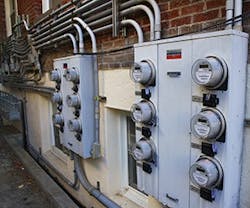If you pay your building’s energy bills each month but ignore your long-term vulnerabilities, you run some risks from both foreign and domestic factors.
For decades, people have been talking about U.S. “energy independence,” particularly during times when foreign oil supplies have been threatened. And in fact, our dependence on foreign oil has decreased. In recent years, foreign oil has decreased from 60% to about 45% of U.S. consumption, according to the Energy Information Agency. Nevertheless, the flow of dollars overseas remains an important national issue. We currently spend about $25 billion per month on foreign oil (252 million barrels/month @ $100/barrel). In addition, we spend to protect our access to this foreign oil, which represents 22% of total foreign supply. An aircraft carrier group deployed to the Persian Gulf costs about $2.6 billion annually, and currently there are two groups deployed there. That money impacts our economy and our energy supply and costs.
Domestic sources also present vulnerabilities. Our electric grid is mostly reliable and powered by a variety of domestic fuels (coal, natural gas, utility-scale renewables, etc.). Still, many businesses and people found themselves without energy for days after Hurricane Sandy. Such downtime is the most expensive impact of energy vulnerability. When evaluating your energy options, also assess your downtime risk and its costs. My friends in the utility industry tell me that grid disruptions are likely to become more frequent due to changing weather patterns, demand fluctuations, infrastructure overhauls, and even solar flares.
Given such vulnerabilities, building managers should focus on a strategy that gives them a measure of control and self-reliance. For example, consider implementing the ability to switch fuels (e.g., electric to natural gas). While this strategy exposes you to new factors (e.g., natural gas pipelines and the size of your storage tank), it nonetheless gives you more flexibility and control.
Most analysts say that the supply of natural gas from “fracking” is too large to ignore and that this abundant, inexpensive and clean (compared to coal) source will change the energy industry at generating plants. If natural gas remains cheap, I can foresee building managers using more gas-fired equipment. This can be cost effective not only for chillers and co-generation units, but also for large fleets and shipping trucks. Boone Pickens says that retrofitting a truck’s diesel engine to operate on natural gas reduces operating costs and provides a 5-year simple payback, a roughly 20% annual return on investment. Where else can you get such a return? Biofuels are another option, but according to EIA, only 1.78 million barrels of biodiesel were produced in the U.S. during October 2012.
Another example of self-reliant energy management is standby power or even co-generation. A success story during Hurricane Sandy is New York University (NYU), which provided electricity and heating for its main buildings throughout the storm with its onsite, natural gas-fired cogeneration plant. In addition to this collateral benefit, the plant has reduced NYU’s carbon footprint by over 30%, along with an 80% reduction in other regulated pollutants.
Why do so many building owners delay developing such strategies? I think that the motivation to change is directly influenced by the amount of sudden pain a business feels. Energy managers must remind management that doing nothing is a decision and that self-reliance is a valuable benefit.
Dependence is depressing. I installed compact fluorescent lamps and LEDs throughout my house yet my electricity costs last year were about the same as the previous year. Upon further inspection of my bills, I noticed that my consumption had decreased about 30%, but our local utility’s price per kWh increased about 30%, a factor over which I have no control. I also don’t have control over my energy taxes, which are influenced by factors like foreign policy and national security decisions. Still, I did avoid a significant expense.
Many commercial building managers are in a similar position. Only when the bills are all in front of you can you see the broader perspective. At that time you can justify to management the purchase of more LEDs or perhaps a solar hot water heater, which could be truly self-reliant much of the time.
But if you only pay your facility’s bill every month, you are missing the opportunity to become energy self-reliant and avoid unnecessary pain and risks.





